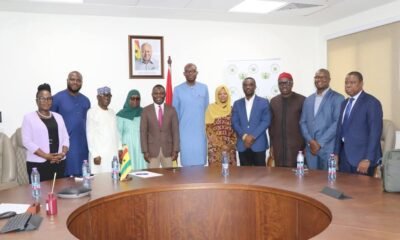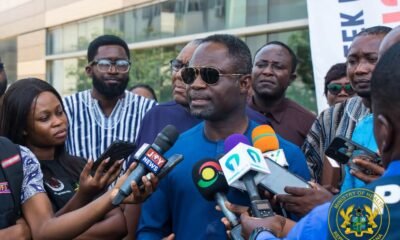News
First Lady inaugurates revamped 118-year-old Independence Avenue Cluster of Schools

proofread
The First Lady, Rebecca Naa Okaikor Akufo-Addo, has inaugurated the newly refurbished Independence Avenue Cluster of Schools in the Asheidu-Keteke Sub-Metropolitan District in Accra.
She was accompanied by the Ga Mantse, King Tackie Teiko Tsuru II, Professor Aaron Mike Oquaye, former Speaker of Parliament, Dr Ernest Addison, Governor of the Bank of Ghana, and Mrs Elizabeth Kwatsoe Tawiah Sackey, Mayor of Accra, to perform the inauguration on Wednesday, September 18.
The redevelopment of the 118-year-old educational facility was done in a collaboration between the Accra Metropolitan Assembly (AMA) and the Bank of Ghana.
The facility has an 18-unit three-storey classroom block and a three-unit nursery block, fully equipped with modern amenities such as science and computer laboratories, libraries, a staff common room, offices, a horticultural garden and a playground for students, among others.
Mrs Akufo-Addo in a speech urged all citizens to adopt the spirit of prioritising the needs of future generations, adding that the modern school would provide quality education and training for children to contribute meaningfully to the country’s development.
She pointed out that the government had made education a priority, resulting in increased access and higher enrolment figures in public schools, stressing that education was crucial for Ghana’s development.
The First Lady called on the management of the school to make good use of the facilities to ensure high-quality education whilst encouraging the students to remain disciplined and strive for success in their academic and personal endeavours.
The Ga Mantse, King Tackie Teiko Tsuru, on his part, expressed gratitude to all stakeholders and acknowledged the significant role played by the Bank of Ghana in supporting the project.
He emphasised the importance of the new school building and called for regular maintenance of the facility in order to ensure its long-term impact on education in the community.
Dr Addison also on his part highlighted the rich history of the school, which was founded in 1906 during the British colonial era, and recounted how the school, originally known as the Accra Government Girls School, served as a centre for the education of girls, including his mother and several other women from Osu.
He recounted how the Bank of Ghana received a request for support through the former headmistress of the school, Mrs Agatha Ama Dzathor, and the then Mayor of Accra, Mr Mohammed Adjei Sowah, for the construction of a modern classroom block, which was approved through its corporate social responsibility.
The Governor praised the collaboration between the Ghana Education Service (GES), the AMA, and the Bank of Ghana in bringing the project to fruition and urged the management of the school to adopt a rigorous maintenance culture to ensure the longevity of the facilities.
Dr Addison also reminded the teachers of their crucial role in nurturing young minds and encouraged students to use the school as a place to explore, innovate, and reach new heights. –GNA
News
National Service Authority to Introduce Military Training

Management of the National Service Authority, yesterday, Wednesday, April 23, 2025, held talks with the Military High Command towards the implementation of the National Service Emergency Response Readiness Programme (NSERRP).
When implemented, this will reflect His Excellency the President’s commitment towards the implementation of a short military training for National Service Personnel (NSPs) as planned efforts to instill discipline, nationalism and physical fitness among Ghanaian graduates.
The President shared this position during his maiden State of the Nation Address in Parliament on Thursday February 27, 2025.
At yesterday ’s meeting, the Director-General, Mr. Felix Gyamfi reiterated the need for all personnel to undergo basic military drills and orientation as part of orienting the youth to embrace national development.
“The introduction of this military training is a step in the right direction and must be embraced by all and sundry as one of the indicators for resetting the country, particularly the youth,” he commented.
On his part, Brigadier General Amoah-Boakye assured the Authority of their willingness to provide the requisite training for personnel when the Programme officially commences.
In all, personnel will receive up to two months of composite basic military drills starting 3rd August, 2025.

News
Ghana Tourism Authority acts on concerns of minors allegedly taken to Hotel in Accra New Town.

The Ghana Tourism Authority (GTA) has taken swift action following reports circulating on social media regarding an incident involving minors allegedly taken to a hotel in Accra New Town.
The case has been formally reported to the Nima Division of the Ghana Police Service for investigation.
In line with their mandate to ensure safety and compliance in the tourism and hospitality sector, our CEO Mrs.Maame Efua Houadjeto delegated a team from the GTA Head Office, Mr. Gilbert Abeiku Aggrey, Deputy CEO, Special Duties and Mr Ekow Sampson, Deputy CEO, Operations who joined the Greater Accra Regional Director, Ms. Roberta Dawson-Amoah, and the Deputy Director of Marketing, Ms. Clara Nketiah, to visit the said facility.
The objective was to verify the facts on the ground and take necessary regulatory action.
They commended the Ghana Police Service for their co-operation and continued support in the ongoing investigation.
Additionally, the team inspected Royal Dede Beach Resort, which has been converted into a hostel under new management without official notification to the Ghana Tourism Authority.
The team discovered that the hostel’s operations were not in compliance with the L. I 2239. Meanwhile the operator has been directed to the Standards and Quality Assurance Department of the Authority for the necessary regulation.
“We remind all accommodation operators that the Tourism(Registration and Licensing of Accommodation) Regulations, 2016 (L.I. 2239) mandates every facility to register and obtain a license from the GTA before commencing operations.
This regulation ensures quality, safety, and compliance across the industry,” they noted.
The GTA they said, remains committed to safeguarding the public and upholding the highest standards in the hospitality sector and urged
the public to report suspicious or non-compliant facilities to the nearest GTA office.







